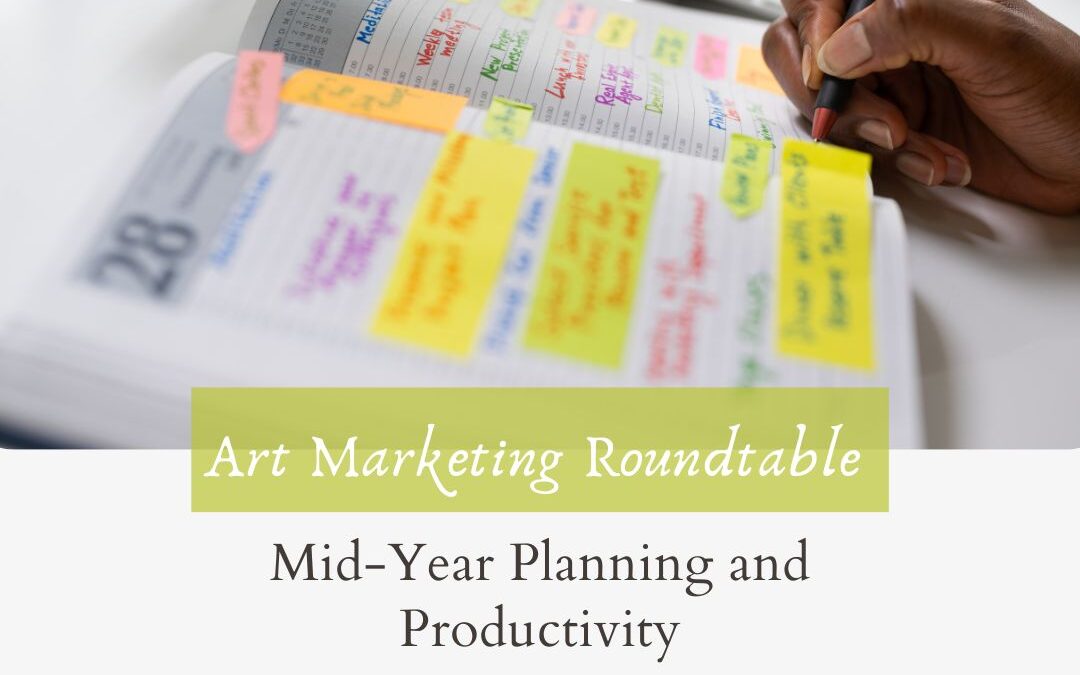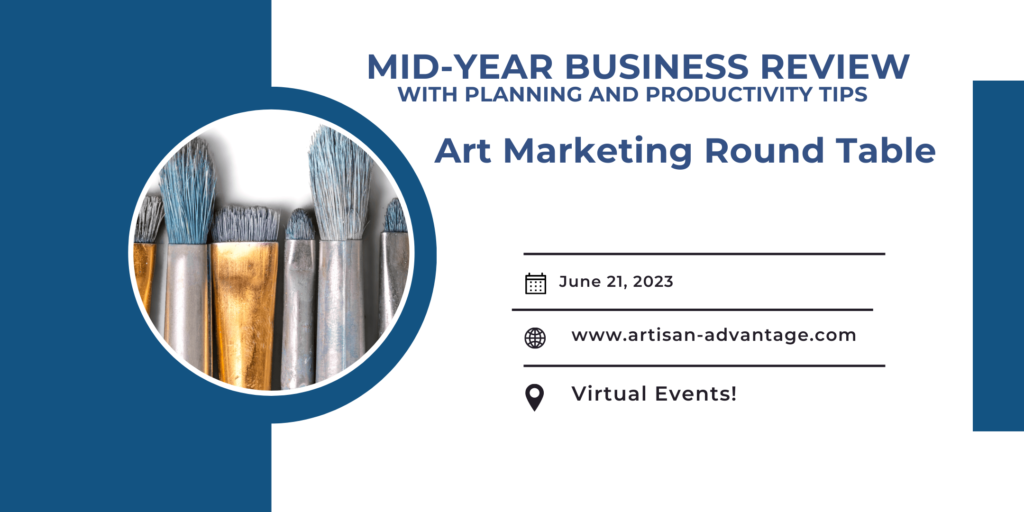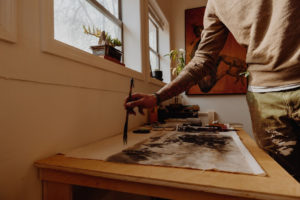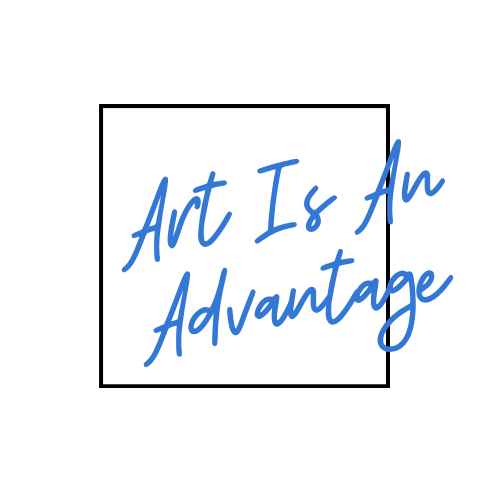
by Rebecca Sciullo | Jun 14, 2023 | Learning, Planning, Productivity, Time Management, Tools
How’s Your Year Going?
Do you plan once for your year and then not look at it again for the rest of the year? If you do, you’re not alone. It’s not uncommon to make solid plans and then get so busy with your work that you don’t check back in to assess how things are going.
Or, do you not have a plan but rather roll with things, creating work and putting it out there on your website or social media, hoping something will happen? Again, you’re not alone. The good news is there is always time to start making a plan.
You may have a plan and want to be more productive and assess how to improve things along the way.
For all three of these scenarios, and everything in between, join an upcoming art marketing round table where we will talk about doing a mid-year review for your art business and sharing productivity and planning tips.

How to do a Mid-Year Review for Your Art Business
Planning is for more than just the beginning of the year. Artists should periodically take stock of how things are going and where they need to adjust their plans. Do this with a mid-year review. And, if you’ve never made a plan for your business, you don’t have to wait for the beginning of the year to start. Instead, learn strategies to get started with art business planning at any stage of the game.
This art marketing round table will focus on a mid-year review of your art business. We will discuss the review process and areas you should consider when going through this process. Discussion points will include assessing your performance, systems, and goals over the past six months. Then, take that information to determine areas of adjustment and improvement for the rest of the year. This comprehensive evaluation will guide your decision-making in growing a vibrant art business. Going through this process will help you to re-evaluate and clarify goals, optimize your practices, and foster a plan for business growth.
We will also discuss productivity and time management techniques.
Art Marketing Round Table: Mid-Year Planning – Wednesday, June 21, 2023
3:00 pm EST/12:00 pm Pacific
https://www.eventbrite.com/e/640713139247
Free Event to Help Your Art Business
This event is free, but space is limited.
For more information about upcoming round tables and other resources to help with your art marketing, please join my email newsletter.

by Becky Sciullo | Dec 1, 2021 | Planning, Productivity
It’s December 1st! Make this last month of the year count.
Year-end reviews and planning for next year are always a hot topic this time of year, and I encourage you to do that.
In addition to a year-end review and planning for the next year, there is one critical activity I’ve got in the habit of doing every year. This activty ensures that I hit the ground running in January. It also helps me stay on track during a month typically filled with holiday events, parties, and travel. I like to refer to it as a “home-stretch” plan.

What does this “home stretch” plan entail?
As the year is coming to a close, a home stretch plan is simply a quick list of things that I would like to accomplish before the end of the year. I consider outstanding projects that I would like to wrap up. Then, I think about things I would like to have in place when I hit the ground running in January.
Before Thanksgiving, I sat down to figure out my “home stretch plan” and came up with the following priorities for the next four weeks. Some of the things on my plan included:
Make health a priority with healthy eating and exercise, mindful of the many opportunities coming up to indulge.
Helping my daughter tie up some loose ends regarding her post-graduate plans after high school.
Finish a product that I’ve been working on for too long now. It’s time to get it done.
Finally, make headway with or possibly (but realize it might not be realistic) complete my new website.
Keep it Simple
I like to keep it simple. Yes, I have holiday planning and other things to do, but these are the four things that I am focusing on going into the New Year. I use it as a reference to make sure I make time count during this busy month.
It doesn’t take long to do. Give some thought to your “home stretch plan” today so you can make these next four weeks count and hit the ground running in January. Leave yourself plenty of room for rest, relaxation, and holiday cheer, but help yourself get a leg up so you will feel ahead of the game on New Years Day.
Photo by Miguel A. Amutio on Unsplash
by Rebecca Sciullo | Jun 10, 2020 | Artist Blogging 101, Learning, Productivity
Since many people are working at home now, there are many articles and information on social media about productivity. It can be challenging to work from home under the best circumstances. Throw a couple of homeschooling kids and other homebound family members in the mix, and it is tough to avoid distractions. You need to understand how to manage your time and resources efficiently.
This situation might be old news for you if you are a working artist. You are probably already used to working on your own. If not, you wouldn’t get anything done. One artist I know wakes at 4:30 a.m. to get a start on his day. He knows that this is the golden time when he can create and work in the studio. I find that early mornings are best for me, although I can’t say I rise that early!

Starting an Artist Blog Takes Time and Focus
If you’ve recently started a blog, adding this task into your daily routine can be a challenge, and you might need a refresh on some productivity ideas. Here are a few ideas that I’ve used to manage my situation.
1 – Figure out what time of day works best for you to focus on different tasks. When do you find your energy best suited for writing or focused at your computer, brainstorming ideas?
2 – Once you determine the best time of day for this work, regularly block it out on your calendar daily or weekly. Do not deviate from your schedule. Treat this time as though it is an appointment outside of the house.
3 – Avoid things that suck your energy while working in your block or zone. The usual culprits include email, television, and social media.
4 – Create a pleasing workspace.
5 – Last but not least – take some breaks. use a Pomodoro Timer. I like to get outside for sunshine and fresh air.
Maintaining an artist blog is not just about technical know-how and writing. There is an art to staying on track and growing your site. Find and stick with strategies that help you to do this.
If you’d like more idea on how to maintain your artist blog, please sign up for my regular newsletter.
by Rebecca Sciullo | Oct 2, 2018 | Learning, Planning, Productivity, Time Management
 “I don’t have time.”
“I don’t have time.”
If you’re like most people, you probably say or think those words quite often. Lack of time often becomes a catch-all excuse for not getting work done in your art business – like creating, learning or just slowing down, taking time to plot and plan out your next steps.
Between work, family needs, school, and the endless items on your to-do list, it can be tough to find a spare minute to return an email, much less to post on social media, find and apply to shows or make it to a networking event. It may seem like if you just had one extra hour in the day, you would finally be able to fit in everything you want to do in your art business.
But the truth is, no one has an unfair advantage in the time department. We are all given the same 24 hours each day and it’s up to us how we choose to use them. Of course, there are certain things that simply must get done, like working and eating and taking care of a family. However, with some thoughtful planning, you can boost your day-to-day productivity and maybe even find some extra pockets of time to squeeze in what’s been eluding you.
If you can’t do a lot, do a little.
It’s easy to become paralyzed by the prospect of a large, time-consuming project whether that’s organizing your inventory, building a website or making time for your studio every day. When you hold yourself to sky-high standards and then miss the mark, it’s common to fall victim to the “all-or-nothing” mentality, which sounds something like this: “I missed my studio time today, so what’s the point of even trying to work”
Instead of overwhelming yourself and setting yourself up for failure, look for small ways to chip away at your goals, such as taking inventory of two pieces of art a day or simply working in your studio for twenty minutes.
Do the tough tasks first.
Take care of the most challenging or unpleasant tasks before you have a chance to talk yourself out of them. Hate networking? Attend an event that meets the first thing in the morning. Dreading posting on social media?. Schedule 15 minutes at the start of the day to do it, so it’s not nagging at you all day. Completing a tough task early will give you the motivation to plow through the rest of your day.
Schedule regular studio time.
Can’t schedule a large block of time in the studio every day? Can you try for a half an hour? Put it on your schedule and treat it like a real appointment, just as you would a client meeting. Whether it’s right when you wake up or in the space between dinner and bedtime, put it on your calendar along with your other tasks. As this starts to become a habit, try to gradually add a little more time until you’ve worked up to the ideal amount of time per day for your studio practice.
Get help.
It’s hard to let go of control of things, but you can only do so many things in a day. Sometimes, getting help is the only way to get everything done. You can’t hire someone to make your art for you. You can possibly ask your family members to help out around the house more or hire a cleaning service. Free up some time to focus on your business.
Eliminate unnecessary activities.
While everything on your plate might seem essential at first glance, there are likely some activities that can be trimmed. For a few days, track what you do in a day, then review the list. If you find your doing things that aren’t absolutely necessary and aren’t moving you toward your goals, give them the boot. You’ll likely be surprised by how much extra time emerges.
Take breaks.
If you don’t build periods of mental and physical rest into your day, you’ll find yourself taking unintentional ones. For example, you might schedule one or two 15-minute walks throughout the day. This gives you an opportunity to recharge while also sneaking in some thinking time to plan for your business. Or you could plan to reconnect with another artist during a coffee break. Without these planned time-outs, though, you’re more likely to succumb to mindless activities that offer little benefit to your business.
Get Enough Rest
Your might think staying up late helps you to get more out of your day. However, the time you save by sleeping less will likely mean sacrificing some of your energy, focus, and creativity. Resist the urge to burn the midnight oil. Instead, choose to rest and recharge so you can be functioning at your highest level the next day.
Each morning is a new opportunity to use your time more wisely. Be a little more thoughtful about how you use your time each day and you will move closer to meeting your business goals.
Would you like more tips on building your art business? If so, subscribe to the Artisan Advantage Mailing List.
Photo by Elena Koycheva on Unsplash
by Rebecca Sciullo | Sep 21, 2018 | Learning, Planning, Productivity
Stick to it!
 Consistency is essential to success with your art business. But, a regular routine of studio time and business activity is not always an easy thing to maintain.
Consistency is essential to success with your art business. But, a regular routine of studio time and business activity is not always an easy thing to maintain.
You start the week with the best intentions—to spend time in the studio, market your work, and make good choices about how you use your time. Then life happens. The dog is sick. School is canceled for the day. There could be a hundred other things that can get you off track. Before you know it, your plan is in trouble and your goals for the week aren’t looking very doable. Something has to give. Often, “what gives” is that plans for your business that week don’t happen.
So how do you change this pattern? Here are three tips for building consistency.
1 Build momentum one step at a time.
It’s never easy to change old habits or start new routines. The key to long-term consistency is building momentum. The hardest part is always getting things started. But once you’re moving, staying in motion and picking up speed becomes a lot easier. There are a lot of ways you can gradually build momentum as you work. Start with something that’s easy to complete and build from there. For example, set a goal of one social media post a day for your work. Then increase it to a post on two platforms each day. The simple act of setting a small amount of time aside time for this every day and sticking to it is enough to start building the habit.
2 Find an accountability partner.
Find a friend or family member whose judgment and opinion you respect. Each time you find yourself thinking about not sticking to your plan, write down the reason. Share this with your accountability partner and get an honest opinion about whether the reason is justifiable or just an excuse.
3 Always have a plan B.
Life is unpredictable. You need to have plan B ready—even before you actually need it. Plan B helps you to stay consistent with your goals when your regular routine doesn’t work out as planned. Surprises won’t throw you off track if you plan ahead. For example, make a short list of three specific marketing tasks for the week. Then, when you do get even a small amount of time, you can get right to business, rather than sit and think about what you need to do. Or, have your studio set up and ready to go as best as you can, so that when you get a moment to work, you ready. Put a little time into identifying the most common problems that disrupt your routine, and plan (in advance) what you can do to handle these problems without sacrificing your art business goals.
Being consistent does not mean being perfect.
There are days or weeks when it just might not work out how you planned. But, being mindful of how you can handle disruptions in your schedule will help you to stay more consistent in your business.
I hope these ideas help you overcome obstacles that crop up in your art business.
Would you like more tips on building your art business? If so, subscribe to the Artisan Advantage Mailing List.
Photo by Antonio Francisco on Unsplash








